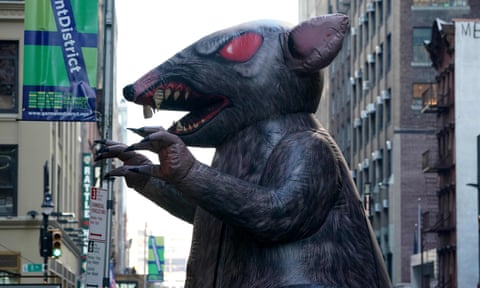In New York – a city poised to hire its first “rat czar” after rat sightings doubled in the past year – street-side rodents are fairly commonplace. But the rat stationed on a Union Square curb is something of a different beast. This one is roughly 10ft tall, with incisors the size of iPads. Its eyes are bloodshot, its claws extended, and its belly marked with what look like open, oozing sores. Depending whom you ask, its name is “Scabby”, or just “the Rat”.
Since January, give or take, the Rat has been strapped into the bed of a Ford F-150, staring down Tammany Hall. The historic building is poised to become a giant pet store, Petco’s New York flagship, a three-floor bestial mall equipped with its own animal hospital.
But Petco has a reputation for hiring non-union contractors and the city’s District Council of Carpenters is protesting the move by inflating a huge Scabby out front. “Shame on Petco,” a nearby LED truck sign reads, “for destroying the area standard wages, health benefits, and pensions for construction workers.”
Most days, the Rat stands there alone. But few need more context; Scabby is, as the name suggests, a familiar signifier of organized labor. He appears beside workers nationwide – at an Amazon warehouse in Illinois over the summer of 2021, at a Philadelphia Starbucks the following July, and at a Rockford gas station just a few months back, where he was “mortally wounded” after a disgruntled employee took it upon himself to “shank defenseless Scabby in his side”.
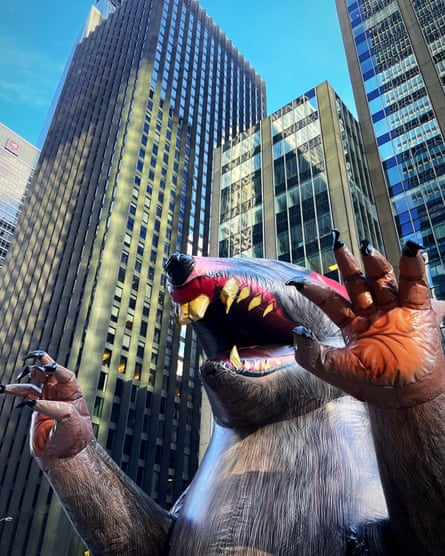
It’s impossible to say how many Scabbies are on the street at any given time, but there are 60 unions in the AFL-CIO, the nation’s largest federation of unions, which represents over 87% of unionized workers in the country – and many, perhaps most, have their own collections of inflatable Scabbies. A representative from the Laborers’ International Union of North America (Liuna) estimated it had “40 or 50 rats” in the eastern region alone. An organizer with the International Union of Bricklayers and Allied Craftsworkers (BAC) guessed it had even more: “I’d be surprised if the number was less than 60.”
The rat elicits polarizing opinions (they tend to fall neatly along worker-management lines). But to both sides, Scabby is, as one organizer told NPR in 2021, an “iconic symbol of a labor dispute”.
If Scabby has name recognition, it is a relatively new feature in the history of American labor. The presence of building-sized rodent inflatables at worker actions was an outgrowth of the post-Reagan era, just a few years after the 1981 Patco air-traffic controllers strike sent union membership, and the wages they fought for, into the gutter. The exact origin of the labor dispute icon is, appropriately, disputed; two Chicago unions claim they independently came up with the idea, and their members still loyally, if somewhat wryly, guard their proprietary stake.
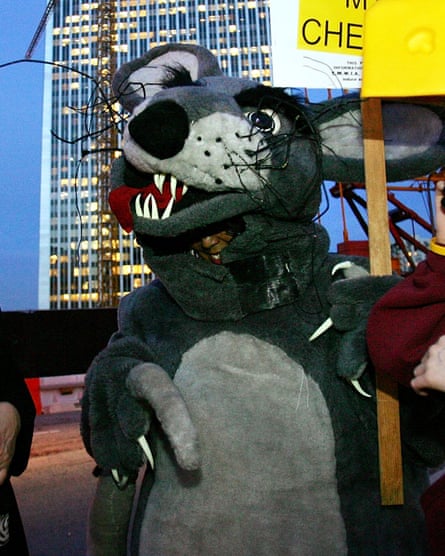
On one side, there’s the International Union of Operating Engineers (IUOE) Local 150, a sheet metal union, whose president, Jim Sweeney, claims he thought it up in 1989 as a new tactic to shame non-union hiring. First, Sweeney made rat costumes to wear at strikes, playing with the idea of “rat contractors”. He found that, in the Chicago summer, the mascot suits acquired a distinctly rat-like smell, so he pivoted instead to a version no one would need to wear: a small inflatable rat roof attachment. Workers would strap it to a Volkswagen painted to look like an exterminator. In November 1989, Local 150 held a “Name the Rat” contest for the balloon and its accompanying Rat Mobile. The next January, it announced the winner: the car would be “Scab Tracker”. The rat was dubbed “Scabby”.
But BAC members dismiss Sweeney’s story. The actual Scabby genesis, BAC claims, came in 1990 or 1991. “There’s no question that the first real Scabby – you know, a giant, ugly looking rat with a nasty belly and all that – was designed by Ken Lambert, who was working for our Chicago District Council at the time,” said Jake McIntyre, the assistant to the secretary-treasurer of BAC. His colleague Lou Padilla agrees. The original model, Padilla said, was still sitting in the Chicago office storage.
Anthony “Dino” Esemplare, an organizer with Liuna, has special insight to the Rat’s biggest break: a cameo in a 2002 episode of The Sopranos, courtesy, he said, of the unionized crew, who had access to a Scabby through the theatrical Teamsters union. “The only reason I know that was because my mother was a cast member on The Sopranos,” he said. “My mother was Frances Esemplare, who played Nucci, Paulie Walnuts’s mom.”
Every Scabby comes from one factory
At least one aspect of Scabby’s backstory is agreed upon – nearly all of the rat balloons across the country have come from a sole distributor: a Plainfield, Illinois, company called Big Sky Balloons. Big Sky was founded in 1980 as a hot air balloon tour business by Peggy and Mike O’Connor, a couple whose interest in activism manifested only as obsessive balloon advocacy. They’d had a balloon-themed wedding, where guests could float around on company vessels; they traveled in their own personal hot air balloon, dubbed August One after their wedding date; and they set a record in 1984, when they became the first married couple to make the 6.5-hour trip across Lake Michigan by balloon. (In 1987, one article notes, Mike floated the idea of birthing their son, Tylor, in a balloon; Peggy shot it down).
Big Sky is partially responsible for the standalone inflatables one sees across America’s curbs. In the early 90s, frustrated by ballooning’s weather sensitivity, the O’Connors developed “an electronic motor and fan system” that kept the inflatables’ form even on Chicago’s windiest days.
The O’Connors, who did not comment for this piece, have backed up BAC’s story in the past: it was Ken Lambert who commissioned the first official Scabby, after seeing Big Sky’s billboard off I-294 and calling them immediately. In interviews, Peggy recalled that Mike had come up with a design and Lambert had given feedback; he wanted it “meaner looking”, with big claws and “festering nipples”.
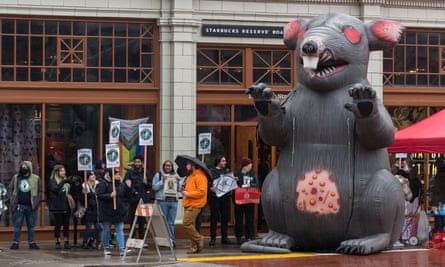
Between the electric motor and burgeoning union business, Big Sky’s sales doubled between 1990 and 1991. It started making inflatable friends for Scabby: a cockroach, a “Corporate Fat Cat”, a “Greedy Pig”. The originals changed, too. “They range in size from 6ft to 14ft,” Padilla said. “Some are yellow. The early ones were just black with white and red bellies.” In the later years, the fingers and whiskers became more menacing. “They would make [the belly] more scabrous,” he added, “with sores on it and stuff.”
Big Sky itself was, incredibly, not a union shop. It made most of its other balloons for major city businesses – the Chicago Bulls, Cubs, and White Sox; the Navy Pier, the Chicago Auto Show, and most car dealerships in the area, employers who could easily have found themselves with a Scabby parked out front. By the late 2010s, Mike was also, according to Padilla, “a big Trumper” who refused to do “any political stuff”. None of that kept Big Sky from selling, at various points, a half-dozen Scabbies per month, at up to $10,000 a pop.
But these days, America’s Scabby supply may be running dry. When I called Big Sky last week, a woman identifying herself as Michelle said that, in the past month, the business had come under new ownership. “We don’t do any of the unions or the rat stuff any more,” she said. “We have nothing to do with the inflatable rats.” The identities of Big Sky’s new owners or their plans for the business remain a mystery. “We’re not at liberty to say,” Michelle repeated, claiming “a lot of stuff is non-disclosure”.
It’s unclear whether the sale will actually change the rat market. The website still advertises a selection of “Union Inflatables”, linking out to an Ohio-based contractor called Inflatable Images. Michelle wouldn’t say how long Big Sky had used its services, and the firm didn’t respond for comment. But one Chicago Tribune article suggests the O’Connors might have been outsourcing Scabbies as early as 1997. “I had the feeling that they never made the rats,” Padilla admitted. Their warehouse was filled with hot air balloons, but nothing for rodent production, he said. And they bought in an outside seamstress when the rats needed repairs.
“I think they used someone else,” Padilla said, but “they didn’t want to let us know. They probably thought we would go around them and order directly from the company. But my intention was just to find out who made them in case they went out of business, which is where we’re at now.”
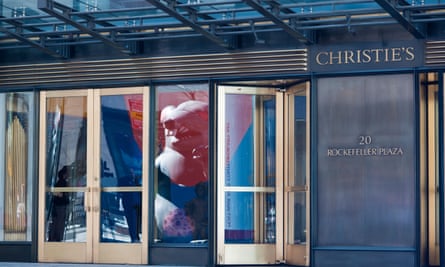
Threat of extermination
Scabbies have survived worse than a supply chain crunch. The inflatables make for an easy and frequent target of anti-union vandalism – attracting over the years countless stabbings, multiple hit-and-runs, at least one “smurfing” incident (getting doused with blue paint), and, per Esemplare, an arrest by NYPD, who held a “super-sized” 30ft version “for interrogation in 1 Police Plaza” for over eight hours.
The rats are also routinely challenged in court. The New York labor attorney Tamir Rosenblum told NPR he had represented Scabby “at least 50 times”, and every few years, federal judges deliberate over whether the Rat constitutes protected speech. There was the time the Illinois town of Orland Park confiscated a Scabby stationed outside the Crystal Tree Golf and Country Club in 2000, prompting a “Free the Rat” rally attended by about 1,000 Scabby fans. Scabby won a federal first amendment lawsuit against the village, as he did again in 2003, when a union sued after an Ohio zoning official threatened strikers with arrest for violating the city’s prohibition on structures in the public right-of-way.
Legally speaking, the Rat has mostly come out on top – outlasting a George W Bush-era National Labor Relations Board lawyer who tried to limit the character’s legal scope in 2006, a New Jersey supreme court case in 2009, and another NLRB challenge in 2011, when the board decided 3-1 in favor of the rat’s rights (the fourth dissented, lambasting the coercive tactics of the “rat collosi”.)
Scabby had less luck in 2018, when a union claimed a sign ordinance in Grand Chute, Wisconsin – which seemed to bar union inflatables, but not Christmas-related ones – discriminated based on content. The town’s code enforcement officer seemed to support the union’s case in court, testifying that Scabby might qualify for the holiday exception “if he donned a Santa hat”. But the seventh circuit disagreed, upholding a lower court’s ruling for Grand Chute.
Just recently the Rat survived its greatest threat of extermination, after Trump appointed Peter Robb, the labor lawyer who led Reagan’s crusade against Patco, and a known Scabby hater, to the NLRB. In 2020, Robb brought a complaint against Local 150, one of the Chicago unions that claimed to have invented it, arguing its inflatables amounted to “secondary boycotts” – or prohibited demonstrations intended to scare away an employer’s business associates. The case was dismissed in 2021, when Joe Biden fired Robb; his replacement declared the proceeding a “waste” of NLRB resources.
Even if Big Sky is out of the rat game, Esemplare doubts unions will struggle to find them: “There’s so many out there that if somebody got jammed up, you can always lend them.” Both Liuna and BAC said they had a stash of 50 or 60, and the Teamsters have taken to loaning their store to smaller shops. “The Rat was a statement,” Esemplare explained. “It wasn’t about Big Sky Balloons – that was just a vendor who was lucky enough to make hundreds of rats for the labor movement.”
“The Rat – when people see that in the streets – they know what that rat means,” Esemplare said. “That there’s people out there trying to better somebody else’s life. It could have been anything. It could have been a squirrel. But we chose a rat.”
